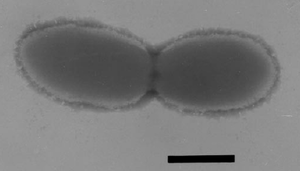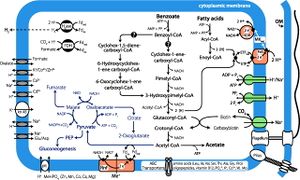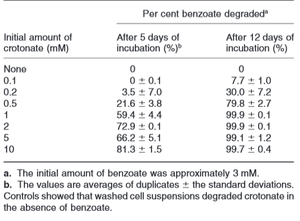Syntrophus aciditrophicus
Classification
Domain: Bacteria
Phylum: Proteobacteria;
Class : Deltaproteobacteria;
Order : Syntrophobacterales;
Family: Syntrophaceae
Species
|
NCBI: Taxonomy |
Syntrophus aciditrophicus
Description and Significance
S.aciditrophicus is an anaerobic, Gram-negative, non-motile, non-spore forming, rod-shaped bacterium. Genes for synthesis of Type IV pili, complete flagella synthesis and chemosensory genes are present. It is a benzoate-degrading bacterium able to degrade fatty acid chains in a symbiotic relationship with methanogens. It has been previously isolated from sewage sludge and can be found in anaerobic environments. [5] it is an organism that has metabolic genes to degrade aromatic and alicyclic compounds and synthesize ATP from acetyl CoA and produces hydrogen. The unique metabolism of syntrophic fatty and aromatic acids of S. aciditrophicus makes this organism stand out from almost all other organisms. Although little information is known about the metabolism of syntrophs, such as S. aciditrophicus , they constitute the missing link in understanding the anaerobic flow of carbon in the biosphere. The unique metabolic pathway that S. aciditrophicus possesses makes scientist think the organism can help anaerobically produce hydrogen from biomass [5].
Genome Structure
The S. aciditrophicus genome is the smallest among all δ-proteobacteria that has ever been discovered.S. aciditrophicus has a single circular chromosome and contains 3,179,300 base pairs and has an average of 51.46% of G+C content, 3169 genes were identified. The genome of S. aciditrophicus contains genes that encodes for proteins that function as a protection from oxidative stress, these proteins includes peroxiredoxin, (S)-2- hydroxy-acid oxidases, Fe-Mn superoxide dismutase, thioredoxin and catalase. For an obligate anaerobe there weren’t any genes identified for superoxide reductase system in S. aciditrophicus. There were few genes that encode for efflux pumps which in turn deal with metal resistance and antimicrobial compounds. The analysis of the S. aciditrophicus genomes showed genes which encode for small heat shock protein and chaperones. The genome has multiple genes for AMP-forming ligases thought to activate aromatic compounds. Some of these genes encode for cyclohex-1,5-diene-1-carboxyl-CoA hydratase, 6-hydroxycyclohex-1-ene-1-carboxyl-CoA dehydrogenase, 6-oxocyclohex-1-ene-1-carboxyl-CoA hydrolase, and 3-hydroxypimelyl-CoA. Also, five genes were found which encode for cold shock proteins, also two genes were found that encode for the universal stress protein. Few identified genes encode for solvent and acid stress response proteins [5,3].
Cell Structure, Metabolism and Life Cycle
S. aciditrophicus’s genome has genes required for synthesis of Type IV pili. These pili may facilitate cell-to-cell attachment to facilitate the transfer of hydrogen and other chemical compound to its syntrophic partners. Although it has a complete set of flagella, structural proteins and chemosensory genes, motility and chemotaxis have yet to be observed in laboratory cultures. The generation time is slow (24-50 hours) with low yield and requires a symbiotic partner. The cell size ranges from 1.0-1.6 μm by 0.5-0.7 μm [5].
S. aciditrophicus’s genome shows limited metabolic options to use any amino acids and carbohydrates for energy conservation. The genome does not contain any carbohydrate transporters, and amino acid and small peptide transporters are very limited. The ability for S. aciditrophicus’s metabolism to break down fatty acid and aromatic compounds are heavily reliant on syntrophic relationship with other organisms. Its genome has an incomplete TCA cycle. S. aciditrophicus may be able to synthesize and use glycogen. It has a complete Embden-Meyerhof-Parnas pathway but lacks any apparent sugar uptake systems. The Embden-Meyerhof-Parnas pathway can be used do generate ATP and NADH from glycogen. However, since it lack any apparent sugar uptake systems it would need to synthesize the glycogen and no glycogen synthesizing genes have been found. It can hydrolyze starch, but it does not grow with it as a sole substrate. S. aciditrophicus's genome has many genes for AMP-forming ligases that have been predicted to activate aromatic and fatty acids. The organism lacks any homolog for acetate kinase, but it does have gene clusters for butyrate kinase and genes for phosphate acetyl/butyryl transferase[5]. Through the use of reverse electron transport it can produce hydrogen and formate. However, without the help of other types of bacteria to consume the hydrogen and formate, S. aciditrophicus would not survive [1,2]. The syntrophic metabolism of S. aciditrophicus resides at a critically low energy yield. Previous studies have shown that pure cultures of S. aciditrophicus can grow and degrade crotonate and benzoate simultaneously. However, without the presence of crotenate, benzoate cannot be degraded. Benzoate can be more readily degraded as concentrations of crotenate increase [6].
Ecology and Pathogenesis
Syntrophus aciditrophicus can be found in anaerobic environment. It has been previously found in sewage sludge. There is no indication that S. Aciditrophicus act as a pathogen but it has been established that it require a syntrophic relationship with a methanogen, and Methanospirillum hungatei has been identifed as a syntrophic partner. Methanospirillum hungatei has been found in anaerobic environments and has been used to anaerobically treat organic wastes such as in the municipal watershed. If one were to grow this bacteria independently of its syntrophic partner to produce hydrogen, it would have great potential to be a biofuel producer. Due to its particular metabolism, Syntrophus aciditrophicus may be used with the help of Methanospirillum hungatei to bio remediate heavily organic environments such as an oil spill. [7]
References
1) Biopact. (2007, April 20). Extremophile’s genome sequenced, may improve biohydrogen production. [Nature Blog Network]. Retrieved from http://news.mongabay.com/bioenergy/2007/04/extremophiles-genome-sequenced-may-lead.html
2) Hooper, R. (2007, April 16).Extreme-living bacteria has genome sequenced. [NewScientist]. Retrieved from http://www.newscientist.com/article/dn11614-extremeliving-bacteria-has-genome-sequenced.html#.VTv1zpO0uZ8
3) Jackson, B. E., Bhupathiraju, V. K., Tanner, R. S., Woese, C. R. and McInerney, M. J. (1999). Syntrophus aciditrophicus sp. nov., a new anaerobic bacterium that degrades fatty acids and benzoate in syntrophic association with hydrogen-using microorganisms. Arch Microbiol, 171, 107-114
4) Kim, M., Buckel, W., Le, H., & McInerney, M. (2013). Identification and characterization of re-citrate synthase in Syntrophus aciditrophicus. Journal Of Bacteriology, 195(8), 1689-1696. doi:10.1128/JB.02185-12
5) McInerney, M. J., Rohlin, L., Mouttaki, H., Kim, U., Krupp, R. S., Rios-Hernandez, L., & ... Gunsalus, R. P. (2007). The Genome of Syntrophus aciditrophicus: Life at the Thermodynamic Limit of Microbial Growth. Proceedings of the National Academy of Sciences of the United States of America, (18). 7600.
6) Mouttaki, H. , McInerney, M. J., & Nanny, M. A. (2008). Use of benzoate as an electron acceptor by Syntrophus aciditrophicus grown in pure culture with crotonate. Environmental Microbiology, 10(12), 3265-3274. doi:10.1111/j.1462-2920.2008.01716.x
7) Stams, A. J. M., Sousa, D. Z., Kleerebezem, R. and Plugge, C. M. (2012). Rold of syntrophic microbial communities in high-rate methanogenic bioreactors. Water Science & Technology, 66(2), 352-362.
Author
Page authored by Gonzalo Campana, Ranya Al Daabil, and Ronald Brown, students of Prof. Jay Lennon at Indiana University.



